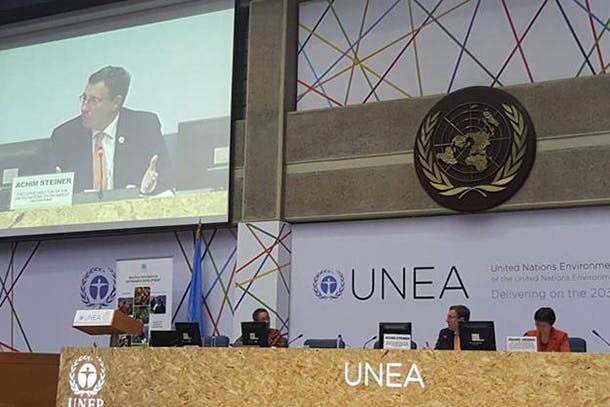
Last month, from May 23-27, hundreds of leaders gathered at the headquarters of the United Nations Environment Programme (UNEP) in Nairobi, Kenya for the second UN Environment Assembly (the first was held in 2014). The goal was “Delivering on the 2030 Environmental Agenda.”
The assembly provides environment ministers, stakeholders, and experts from around the world an opportunity to come together to discuss environmental challenges and work on resolutions to advance action. Achim Steiner, the outgoing Executive Director of UNEP noted that since the first assembly, “The environment has shifted from the\ margins of attention to the center of global decision making. It now runs through the entire 2030 Agenda for Sustainable Development and the Paris Agreement on Climate Change.”
So what happened at the UN Environment Assembly, why does it matter, and how does it relate to achieving the Sustainable Development Goals?
Here are answers to some common questions I’ve received.
What is the UN Environment Assembly, and why is it important?
The UN Environment Assembly is a governance mechanism proposed at the World Summit on Sustainable Development (Rio+20) in 2012 and approved by the UN General Assembly later that year. The Rio+20 conference also adopted “The Future We Want” – calling for a new UN development agenda and negotiation of “Sustainable Development Goals” that were adopted at the UN General Assembly in September 2015. The UN Environment Assembly is the first universal body for the environment in the UN, giving every country a vote and a voice.
The Rio+20 summit in 2012 demonstrated that UN member states, especially developing countries, desire a broad commitment to sustainable development and recognize that natural environmental systems (atmosphere, land, freshwater, and oceans) continue to deteriorate and more concerted efforts are needed. Creating the UN Environmental Assembly brought 194 environmental ministers to the table to review assessments, discuss actions, and make recommendations to governments on actions that should be taken nationally, regionally, and globally every two years.
With the adoption of the Sustainable Development Goals last September, this second assembly was UNEP’s first opportunity to provide input on the implementation of the environmental goals within the new agenda and to highlight that the health of the global environment is essential to future progress.
How did the UN Environment Program shape the agenda at the UN Environment Assembly?
UNEP shaped the agenda by organizing several contemporaneous discussions among participants:
- The Science Forum:
This forum offered government delegations, non-governmental organizations, scientists, and private sector participants a window into the most relevant scientific information on key environmental challenges. In conjunction with the forum, UNEP released the first-ever regional reports for its signature assessment, The Global Environment Outlook, which will be finalized in 2018. - Global Major Groups and Stakeholder Forum (GMGSF):
In adopting the UN Action Platform at the Rio Earth Summit in 1992, the UN approved the participation of nine major civil society groups – women, children and youth, indigenous people, nongovernmental organizations, local authorities, works and trade unions, business and industry, science and technology community, and farmers. These groups now participate as observers in UN economic, environmental, and social discussions as a coalition (GMGSF). UNEP has long been committed to offering this forum a voice in its deliberations. - The Sustainable Innovation Exposition:
The exposition showcased environmental technology from renewable energy to water purification systems to new data management approaches. - The Assembly:
Government delegations attended the UN Environment Assembly to review two years of progress, adopt resolutions on future programming, and to highlight environmental issues that require urgent governmental action.
What were the big issues at the UN Environment Assembly?
- Illegal wildlife trafficking:
Destruction of elephants, rhinos, and tigers continues despite the policies adopted by parties to the Convention to Combat International Trade in Endangered Species (CITES). UNEP estimates that these losses cost developing countries about $200 billion annually. To highlight these concerns, CITES in cooperation with the UN Office of Drugs and Crime released the first World Wildlife Crime Report – setting the stage for international legal action against wildlife trafficking. - Oceans:
The assembly recognized the efforts of UNEP’s Regional Seas Program to counter the proliferation of marine debris – especially microplastics, as well as other chemicals and wastes. UNEP’s role in building capacity for countries to reduce land based pollution and manage coastal zones and coral reefs is central to international cooperation on the oceans. The assembly also noted the imperative for UNEP to collaborate on efforts to protect marine biodiversity and to advise countries on establishing marine protected areas.
- Human health and the environment:
Air and water quality pose major threats to sustainable development. In the Global Environment Outlook’s regional assessments, experts highlighted that outdoor and indoor air quality remain a serious issue causing a combined 7-8 million deaths annually. Improved air quality (an environmental target of the Sustainable Development Goals) contributes to progress on overall health, but particularly that of women and children. Addressing air pollution can also reduce methane, black carbon, particulate matter, and ozone – all factors in exacerbating climate change. - Big data and Multilateral Environmental Agreements:
UNEP showcased its initiative on collecting social, economic, and environmental data on a new, interactive data platform, UNEPLive. The database is designed to help countries to collect data and establish environmental baselines for air and water quality as well as improve environmental monitoring and regulation. It is also designed to help countries collect data and quantify information relevant to implementation of the Sustainable Development Goals and their targets. Data sets are designed to improve national compliance with reporting requirements in the Multilateral Environmental Agreements.
Every resolution, however, reinforced UNEP’s role as the UN system’s collaborative platform for environmental monitoring, reporting, and capacity-building. Establishing the legal framework to take environmental action, however, is the responsibility of the governing body, known as the conference of parties, to each convention.
The assembly adopted UNEP’s Program of Work and Budget and stressed UNEP’s capacity building role in helping UN member states, especially developing countries, implement the Sustainable Development Goals. Decisions made at the assembly also offer the incoming UNEP Executive Director guidance in setting priorities for the organization as he takes charge later this summer.
How the High-Level Political Forum on Sustainable Development incorporates the resolutions from the UN Environment Assembly into its broad agenda next month will better define how these two new intergovernmental bodies will support the implementation process of the global goals. That said, the opportunity for environmental ministers to highlight issues impacting the Sustainable Development Goals is an important one and as the UN Environment Assembly’s interaction with the High-Level Political Forum increases, member states are likely to better recognize
the cross-sectoral impact of environmental issues on sustainable development.
[Photo: UNEP]



 View All Blog Posts
View All Blog Posts